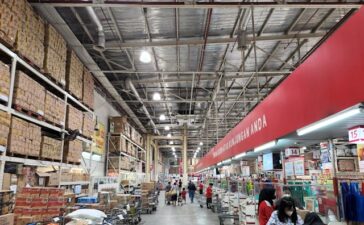Welcome to our blog post all about resilient flooring! If you’re in the market for a durable and versatile flooring option, then look no further. Resilient flooring is here to save the day! Whether you have a bustling household with kids and pets or simply want a low-maintenance solution, resilient flooring has got you covered. In this article, we’ll explore what exactly resilient flooring is, the different types available, its numerous benefits, how to install it, and most importantly – how to keep it looking pristine for years to come. So let’s dive right in and discover why resilient flooring may be the perfect choice for your home or commercial space!
What is resilient flooring?
Resilient flooring, also known as vinyl flooring, is a type of flooring that is designed to be durable and long-lasting. It is made from synthetic materials such as PVC (polyvinyl chloride), which gives it its resilience and flexibility. Resilient flooring comes in various forms including sheets, tiles, or planks.
One of the key features of resilient flooring is its ability to resist moisture and stains. This makes it an excellent choice for areas prone to spills or high humidity, such as kitchens and bathrooms. It can withstand water without warping or deteriorating, making it a practical option for busy households.
In addition to being waterproof, resilient flooring offers excellent resistance against scratches and dents. This makes it ideal for high-traffic areas like entryways or living rooms where furniture may be moved around frequently.
Another advantage of resilient flooring is its easy maintenance. Regular sweeping or vacuuming followed by mopping with a mild cleaning solution is usually all that’s needed to keep it looking fresh and clean.
Thanks to advancements in technology, modern resilient flooring now comes in a wide range of designs and patterns that mimic natural materials like wood or stone. Whether you prefer the warm look of hardwood or the sleek appearance of tile, there’s sure to be a style that suits your taste.
Resilient flooring provides an affordable yet stylish solution for those seeking durability without compromising on aesthetics. Its versatility and ease-of-care make it an excellent choice for homes with children or pets – providing peace of mind knowing your floors can handle whatever life throws at them!
The different types of resilient flooring
The different types of resilient flooring offer a wide range of options for homeowners. One popular type is vinyl flooring, which comes in sheets or tiles and provides durability and water resistance. It’s also available in various styles, colors, and patterns to suit different aesthetics.
Another option is linoleum flooring, made from natural materials like linseed oil and cork powder. Linoleum is known for its eco-friendly properties as well as its resilience against scratches and stains.
For those seeking a more luxurious feel, there’s luxury vinyl tile (LVT), which mimics the look of hardwood or stone but at a lower cost. LVT is also highly durable and easy to maintain.
If you prefer something softer underfoot, consider cork flooring. Cork has natural cushioning properties that make it comfortable to walk on while still being resistant to moisture damage.
Rubber flooring offers excellent durability and slip resistance in high-traffic areas like gyms or commercial spaces.
Each type of resilient flooring has its own unique qualities that cater to different needs and preferences. Whether you prioritize style, sustainability, or practicality, there’s an option out there for you!
The benefits of resilient flooring
Resilient flooring offers a multitude of benefits that make it a popular choice for both residential and commercial spaces. One major advantage is its durability. Resilient flooring, such as vinyl or linoleum, is designed to withstand heavy foot traffic, making it ideal for high-traffic areas like kitchens and hallways.
Another benefit of resilient flooring is its water resistance. Unlike other types of flooring, such as hardwood or carpet, resilient floors are resistant to water damage. This means they can be easily cleaned with just a damp mop or cloth without worrying about moisture seeping into the material.
In addition to being durable and water-resistant, resilient flooring also provides excellent comfort underfoot. Its cushioned surface helps absorb impact and reduces strain on joints compared to harder surfaces like tile or concrete.
Furthermore, resilient flooring comes in a wide range of colors and patterns, allowing you to find the perfect style that suits your design preferences. Whether you want something sleek and modern or traditional and timeless, there’s a resilient floor option for every aesthetic.
Maintenance is a breeze with resilient flooring. It requires minimal upkeep compared to other materials – simply sweeping regularly and occasionally mopping will keep it looking clean and fresh for years to come.
Overall,resilient flooring offers numerous benefits including durability,wat er resistance ,comfort,color variety,and easy maintenance,making it an excellent choice for any space
How to install resilient flooring
Installing resilient flooring is a straightforward process that can be done by homeowners with basic DIY skills. Here’s a step-by-step guide to help you install resilient flooring in your home.
First, gather all the necessary tools and materials for the installation. This may include a utility knife, adhesive or tape, a measuring tape, a straight edge, and of course, the resilient flooring itself.
Next, prepare the subfloor by ensuring it is clean and level. Remove any existing flooring and repair any damage or unevenness. If needed, apply an underlayment for added cushioning and soundproofing.
Measure the room carefully to determine how much material you will need. It’s always best to purchase slightly more than what you think you’ll need to account for mistakes or future repairs.
Start by laying out your first row of resilient planks or tiles along one wall, leaving a small gap between them and the wall for expansion. Use adhesive or double-sided tape as recommended by the manufacturer to secure each piece in place.
Continue installing subsequent rows until you’ve covered the entire floor area. Trim any excess material as needed using a utility knife and ensure that all seams are tightly fitted together.
Once everything is installed, allow sufficient time for the adhesive to dry before walking on or placing furniture on top of your new resilient flooring surface. Also, visit Inlinefloors website and get a quotations
Remember to read and follow all instructions provided by manufacturers carefully during every step of installation to ensure optimal results. With proper planning and execution, installing resilient flooring can be an achievable DIY project that adds durability and beauty to your home interior!
How to care for resilient flooring
Taking care of your resilient flooring is essential to maintain its durability and beauty. By following these simple tips, you can ensure that your resilient flooring lasts for years to come:
1. Regular Cleaning: Sweep or vacuum the floor regularly to remove dirt and debris. Use a damp mop with a mild cleaner specifically designed for resilient flooring to remove any stains or spills.
2. Avoid Harsh Chemicals: Avoid using harsh chemicals, abrasive cleaners, or steam mops on your resilient flooring as they can damage the surface. Stick to gentle cleaning solutions recommended by the manufacturer.
3. Prevent Scratches: Place felt pads under furniture legs and use rugs in high-traffic areas to prevent scratches on the floor’s surface. Avoid dragging heavy objects across the floor.
4. Protect from Moisture: Wipe up any spills immediately to prevent water damage or staining. Place mats at entryways and consider using moisture-resistant underlayment if installing in areas prone to moisture like bathrooms or basements.
5. Handle with Care: Be cautious when moving heavy appliances or furniture on your resilient flooring as excessive weight can cause indentations or tears in the material.
6.
Don’t Forget Regular Maintenance:
Resilient floors may need occasional maintenance such as buffing, waxing, sealing depending upon their type and condition.
By incorporating these care practices into your routine, you can extend the life of your resilient flooring while keeping it looking pristine and beautiful!
Remember that proper installation, regular cleaning, and maintenance are key factors in preserving the resilience of your flooring investment over time! With its versatility, durability,and easy maintenance requirements,resilient





